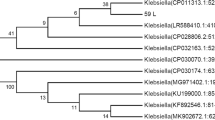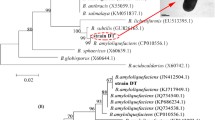Summary
The pure culture flocculation of Flavobacterium sp. strain 304 was shown to be limited to early stationary phase cells. The effects of proteolytic, cellulolytic and nucleolytic enzymes as well a agents such as divalent ions, citrate, malate, EDTA, poly-l-lysine, and NaN3 on flocculation was studied. The results indicate that the flocculation of strain 304 is protein mediated, and affected by composition of the growth medium. The primary interaction between the cells is not ionic or divalent cation dependent, but probably hydrophobic in nature. In addition, the role of single-species flocculation in activated sludge is discussed.
Similar content being viewed by others
References
Angelbeck DI, Kirch EJ (1969) Influence of pH and metal cations on aggregative growth of non-slime-forming strains of Zoogloea ramigera. Appl Microbiol 17:435–440
Benedict RG, Carlson DA (1971) Aerobic heterotrophic bacteria in activated sludge. Water Res 5:1023–1030
Deinema MH, Zevenhuizen PTM (1981) Formation of cellulose fibrils by Gram-negative bacteria and their role in bacterial flocculation. Arch Microbiol 78:42–57
Easson DD Jr, Sinskey AJ, Peoples OP (1987) Isolation of Zoogloea ramigera I-16-M exopolysaccharide biosynthetic genes and evidence for instability within this region. J Bacteriol 169:4518–4524
Endo T, Takahashi H (1980) Reconstitution of pronase-susceptible flocs of Flavobacterium sp. Agric Biol Chem 44:2413–2418
Endo T, Takahashi H (1981a) Genetic evidence for the involvement of aggregation factor and other components in flocculation of Flavobacterium strain B. Agric Biol Chem 45:379–383
Endo T, Takahashi H (1981b) Partial purification and some properties of aggregation factor from pronase-susceptible floc forming Flavobacterium strain B. Agric Biol Chem 45:513–516
Endo T, Nakamura K, Takahashi H (1976) Pronase-susceptible floc-forming bacteria: relationship between flocculation and calcium ion. Agric Biol Chem 40:2289–2295
Forster CF (1981) Activated sludge surfaces in relation to the sludge volume index. Water Res 5:861–870
Forster CF (1985) Factors involved in the settlement of activated sludge — I. Nutrients and surface polymers. Water Res 19:1259–1264
Friedman BA, Dugan PR, Pfister RM, Remsen CC (1968) Fine structure and composition of the zoogloeal matrix surrounding Zoogloea ramigera. J Bacteriol 96:2144–2153
Friedman BA, Dugan PR, Pfister RM, Remsen CC (1969) Structure of exocellular polymers and their relationship to bacterial flocculation. J Bacteriol 98:1328–1334
Gray NF (1989) Biology of wastewater treatment. Oxford University Press, Oxford, UK
Hantula J, Kurki A, Vuoriranta P, Bamford DH (1991) Rapid classification of bacterial strains by SDS-polyacrylamide gel electrophoresis: population dynamics of the dominant dispersed phase bacteria of activated sludge. Appl Microbiol Biotechnol 34:551–555
Hejzlar J, Chudoba J (1986) Microbial polymers in the aquatic environment — I. Production by activated sludge microorganisms under different conditions. Water Res 20:1209–1216
Kakii K, Kitamura S, Shirakashi T, Kuriyama M (1985) Effect of calcium ion on sludge characteristics. J Ferment Technol 63:263–270
Kakii K, Kitamura S, Shirakashi T, Kuriyama M (1986a) Comparison of mucilage polysaccharides extracted from sewage activated sludge. J Ferment Technol 64:51–56
Kakii K, Sugahara E, Shirakashi T, Kuriyama M (1986b) Isolation and characterization of a Ca++-dependent floc-forming bacterium. J Ferment Technol 64:57–62
Kato A, Izaki K, Takahashi H (1971) Floc-forming bacteria isolated from activated sludge. J Gen Appl Microbiol 17:439–456
Krieg NR (1984) Bergey's manual of systematic bacteriology, vol 1. Williams and Wilkins, Baltimore
Krul JM (1977) Some factors affecting floc formation by Zoogloea ramigera, strain I-16-M. Water Res 11:31–36
Kurki A, Hantula J, Vuoriranta P, Bamford DH (1989) Floc formation mechanism of activated sludge bacteria. Water Sci Technol 21:1637–1638
Maniatis T, Fritch EF, Sambrook J (1982) Molecular cloning: a laboratory manual. Cold Spring Harbor Laboratory, Cold Spring Harbor, N. Y.
Morgan JW, Forster CF, Evison L (1990) A comparative study of the nature of biopolymers extracted from anaerobic and activated sludges. Water Res 24:743–750
Nishikawa S, Kuriyama M (1968) Nucleic acic as a component of mucilage in activated sludge. Water Res 2:811
Olkkonen VM, Ojala PM, Bamford DH (1991) Generation of infectious nucleocapsids by in vitro assembly of the shell protein on to the polymerase complex of the dsRNA bacteriophage φ6. J Mol Biol 218:569–581
Pavoni JL, Tenney MW, Echelberger WF Jr (1972) Bacterial exocellular polymers and biological flocculation. J Water Pollut Control Fed 44:414–431
Sato T, Ose Y (1980) Floc-forming substances extracted from activated sludge by sodium hydroxide solution. Water Res 14:333–338
Steiner AE, McLaren DA, Forster CF (1976) The nature of activated sludge flocs. Water Res 10:25–30
Tago Y, Aida K (1975) The deflocculating enzyme produced by a floc-forming bacterium. J Gen Appl Microbiol 21:365–374
Tago Y, Aida K (1977) Exocellular mucopolysaccharide closely related to bacterial floc formation. Appl Environ Microbiol 34:308–314
Takiguchi Y (1972) Purification of the mucilage in activated sludge and its physico-chemical properties. J Ferment Technol 50:331–340
Tenney MW, Verhoff FH (1973) Chemical and autoflocculation of microorganisms in biological wastewater treatment. Biotechnol Bioeng 15:1045–1073
Tezuka Y (1967) Magnesium ion as a factor governing bacterial flocculation. Appl Microbiol 15:1256
Tezuka Y (1969) Cation-dependent flocculation in a Flavobacterium species predominant in activated sludge. Appl Microbiol 17:222–226
Unz RF, Farrah SR (1976) Exopolymer production and flocculation by Zoogloea MP6. Appl Environ Microbiol 31:623–626
Witthauer DP (1980) Biocoenosis degradation in model wastewater treatment plants. Eur J Appl Microbiol Biotechnol 9:151–163
Author information
Authors and Affiliations
Additional information
Offsprint requests to: D. H. Bamford
Rights and permissions
About this article
Cite this article
Hantula, J., Bamford, D.H. The efficiency of the protein-dependent flocculation of Flavobacterium sp. is sensitive to the composition of growth medium. Appl Microbiol Biotechnol 36, 100–104 (1991). https://doi.org/10.1007/BF00164707
Received:
Accepted:
Issue Date:
DOI: https://doi.org/10.1007/BF00164707




